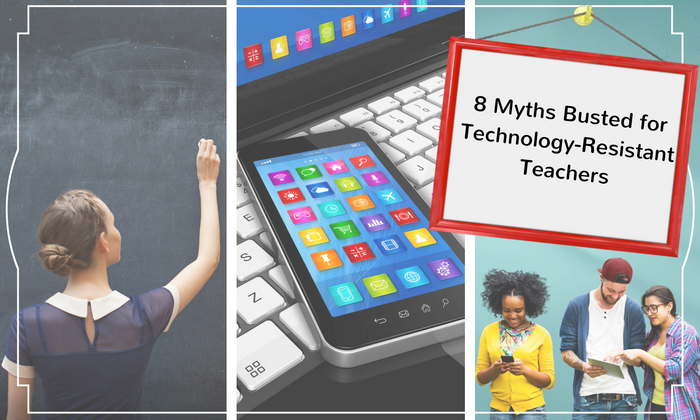8 Myths Busted for Technology-Resistant Teachers
“21st Century Teaching” is here to stay and will only continue to evolve, whether we like it or not. There are dozens of other monikers and educational buzzwords to describe the modern style of teaching that incorporates technology into classroom instruction, and some of us are early adopters. But many educators are still reluctant to embrace the use of technology in the classroom — this may be due to personal obstacles, district hurdles, or just a preference for the more traditional educational environment. Whatever the reason, technology-resistant teachers usually harbor some misconceptions about teaching with tech, which can lead to many missed opportunities. It’s time to bust some common myths for techno-phobic teachers:
1. Myth: Implementing Tech in the Classroom is Complicated
False (or at least it doesn’t have to be complicated). Most educational technology is designed to be as user-friendly as possible for both the student and the teacher, meaning that generation gaps are no longer an excuse to avoid the latest apps and activities. Even if your school is not 1-to-1 with device access for each student, there are many ways to incorporate technology into the conversations and classroom activities that bolster a unit of instruction.
Something super easy, like a green-screen app (or other activity-focused apps and sites) doesn’t require all the hardware integration and set-up that an account-based, global classroom solution would. Getting away from classroom management and online instruction and steering towards something that will inspire collaboration and interest as a portion of a lesson is generally feasible and more simple.
Easy-to-use, web-based apps like Skype and Twitter lend themselves to a teacher using his or her device in the classroom and projecting or screencasting the activity onto the board or TV (if there is one). Communication-based activities like these, when layered into classroom lessons, can spark real-world conversations and broaden perspectives. In addition to exploring online learning communities and communicating with other classes, sites like Kahoot would enable a teacher to create fun and interactive quizzes online and at home that students could then access from their smartphones while in class or in the school’s computer lab.
- More: You don’t have to do it all at once. Start small, and take baby steps
- More: Simplify your quizzes and assessments easily
2. Myth: It Costs a Lot of Money to Integrate Classroom Technology
You’re probably thinking of the cost of wiring a building for device access for every student, getting the school on reliable wi-fi with adequate bandwidth, and purchasing 1,000 iPads, but tech integration continues to evolve and, with it, educators everywhere are discovering new ways to get involved. Yes, supporting and fully integrating the infrastructure and hardware necessary to support 1:1 initiatives and a technology-driven environment is expensive for schools and districts that have the budget for it, however, when schools or districts don’t have a tech budget, there can be workarounds. Classroom tech integration on a budget is possible. You just have to think “outside the box.”
- More: There are so many cool (and free) ways to engage students with tech
- More: Integrating Technology with Limited Resources
- More: Integrating Technology on a Limited Budget with Little Support
3. Myth: In a School Without Devices, Classroom Tech is Impossible to Support
Whether your school lacks the funding, infrastructure, administrative support, or all of the above, that doesn’t mean your students have to be deprived of the ability to learn in modern ways. A BYOD environment can make it significantly easier for even the most technology-resistant teachers to connect everyone without spending district dollars, and there are free tools that can be used creatively in the classroom on one’s personal device or in a computer lab.
- More: Encourage the use of tech outside of class to complete assignments
- More: Professional development focused on ed-tech philosophies offers teachers many creative ways of bridging the digital divide in the classroom
4. Myth: My Students Are Used to My Teaching Style, They Won’t Adapt Well to Change
You’d be surprised. First of all, this generation of students is unlike any other we’ve ever met. All they do is adapt to change — rapidly. And there’s no reason for technology to override your teaching style; if anything, it should only enhance it!
- More: New techniques like mindfulness (which are easily supported with technology) improve the classroom environment and students’ focus and attitudes
- More: 5 Ed-Tech Tools to Combine Reading and Writing
- More: Technology makes it possible to differentiate instruction in ways we could never before imagine, which does wonders for learners’ progress

